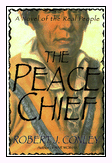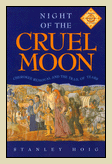The Peace Chief
by Robert J. Conley
It is the early days of European expansion into America, and a young Cherokee must be reborn in order to lead his people through this difficult time.
A sweeping novel of the sixteenth-century Cherokee, The Peace Chief is the story of Young Puppy, a young man who, during a fight with the enemy Ofos tribe, mistakenly kills his best friend, Asquani. That it happened by mistake make no difference. Young Puppy, as a member of the Long Hair Clan, has killed a member of the Wolf Clan and now things are out of balance between the clans. The usual solution is for a Wolf to kill Young Puppy. But he has fled to Kituwah, a Mother town, wherein no one may be killed. If he should leave, he would be killed, but if he remains within its borders until the new year, his offense will be forgotten.
Thus begins the journey of Young Puppy--a man who is spiritually reborn as "Comes Back to Life" and comes to lead his people as the ceremonial leader, the Peace Chief. During a time of uneasy relations with the French, and incursion from the Spanish, and trouble with the Senika (Seneca), Comes Back to Life must guide his people along a difficult path. The Peace Chief is a powerful evocation of a time and of a people.

|
Night of the Cruel Moon: Cherokee Removal and the Trail of Tears
by Stanley Hoig, Stan Hoig
Using many first-person accounts, Hoig describes the events that led up to the forced removal of the Cherokee people from their homeland to the Indian Territory in 1838. The narrative, packed with details and well-documented information, is not a personalized account but a very factual record of the events that occurred. Sidebars offer additional information about specific persons, but some are rather lengthy and out of context. That aside, Hoig clearly shows the complexity of the situation, discussing intertribal rivalries, disagreements, and warring factions, and buttresses information with quotes from several non-Indians who were appalled at the treatment of the Cherokee people. An annotated list of further readings is appended; illustrations were not seen. Karen Hutt

 |
The Earth Shall Weep
 |
Native Americans continue to hold a special place in the modern imagination. Images of the Native American as "noble savage," as grunting Hollywood brute, or even as nature lover reinforce what author James Wilson describes as "the principal role of Indians in US culture throughout the twentieth century: helping America imagine its own history." Wilson hopes to rescue them from this role and place Native Americans within their own context by attempting to view the Indian-European encounter through their eyes. The result is an engaging history of North America and its peoples--and a welcome addition to the already voluminous literature on the subject.
Wilson weaves Native American oral traditions and archeological, ethnographical, and historical evidence into a compelling narrative. Chapters on regional groups and their histories--from the Algonquians of the Northeast to the Zuñi of the Southwest--emphasize both their differences and their similarities. Wilson also traces the shifting relationships between Indians and non-Indians and investigates the reasons behind their misunderstandings. As Wilson points out, the image of the Native American as spiritual guide and Green Party spokesperson, while more romantic, is no more realistic than the image of the ignorant savage. Frequent excerpts from personal interviews allow Native Americans to speak for themselves and remind us that, far from ending at Wounded Knee, the Native American experience continues to evolve. Wilson's clear prose, command of the subject, and detailed suggestions for further reading make this book valuable to scholars and general readers alike. --C.B. Delaney
 |
Another Country : Journeying Toward the Cherokee Mountains
Hiker, canoer, watcher, listener, and meditator, Camuto observes history and nature in the southern Appalachian Mountains, the former homeland of the expelled Cherokee Indians. Favoring a multilevel, nonchronological format, Camuto extols the magnificence of the land before European contact and laments its appearance today and records in detail the reintroduction to the region of the red wolf. With wildness hemmed into the upper reaches of the Great Smokies, Camuto heads for the heights, where he camps in winter, reducing encounters with humans, and engages in a sensitive reflection on the land and the Cherokees' relationship with it. His inspiration is James Mooney, a government ethnologist from the 1880s who wrote about Cherokee culture, including place-names Camuto sought. As he arrives at these locales, Camuto recalls events, forestry, and wildlife that have retreated to refuges of place or memory. Earnest, wistful, and imbued with the poeticalness of nature, Camuto's work conveys the exhilaration of mountaintops, streams, and predators--and the naturalist's dismay at roads, dams, and tourist traps.

|



